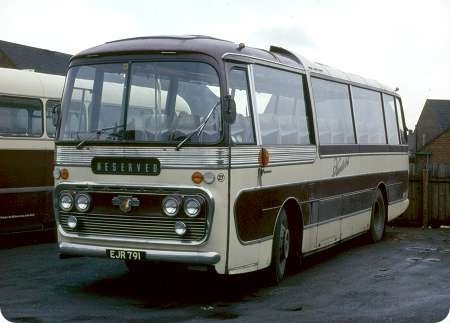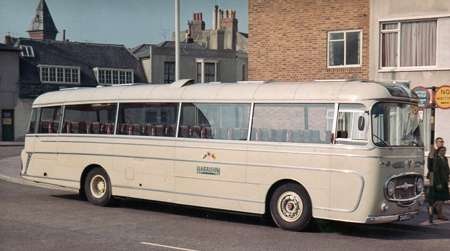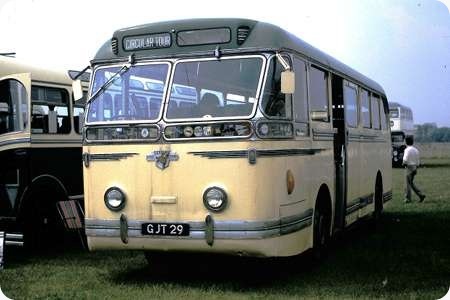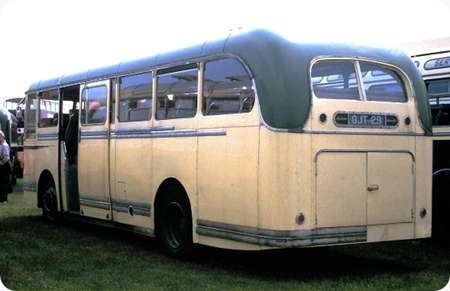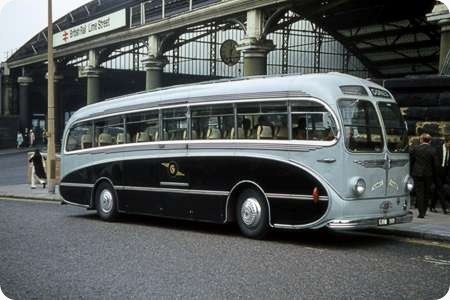Hunters – Leyland Royal Tiger – EJR 791
H W Hunter and Sons
1952
Leyland Royal Tiger
Plaxton C43F (1966)
Hunter’s were a family run business who went for quality rather than quantity. They bought well in the first place, and as we’ve seen before on this site, their vehicles were well looked after and meticulously maintained. ZV 2428 is probably an age related registration that was issued when the original was transferred to someone’s car. That number is on a vehicle that is part of the N.E.B.P.T. Ltd collection. The vehicle in question belonged to H W Hunter and Sons, and is a Leyland Royal Tiger that they bought new in 1952, it came to them as a Burlingham Seagull, and being 1952, I presume it would have been a centre entrance. In 1966, they had it rebodied by Plaxton as a C43F. This vehicle, EJR 791, has an identical history, so the question is, is this in fact the same vehicle, or was it one of a pair?
Photograph and Copy contributed by Ronnie Hoye
30/06/13 – 09:42
Ronnie, nice view!
I remember some vehicles in what was then the Les Gleave Group being lengthened and rebodied in the 1960s. Roman City in Bath did the same trick – using Harrington – on at least one Royal Tiger they bought from Ribble. EJR 791, according to the PSVC preserved bus listing for 2012 is indeed ZV2428, at that time with Universal, Portlaoise.
Pete Davies
I thought ZV and similar registrations are what are popularly known as "Paddy Plates" (I claim Irish blood and am allowed to say this) -Irish registrations with the great advantage of not revealing the (venerable?) age of the coach. These seem/seemed popular with small operators who used them as "personalised" plates.
Joe
01/07/13 – 07:18
The ZV2428 Number probably means that this coach spent some time in Ireland. The ZV plate is used here for imported vehicles that come under a "vintage" registration class which covers vehicles over 30 years old.
David Jones
01/07/13 – 07:35
Mention of the Les Gleave Group lengthening and rebodying a number of Leyland Royal Tigers brought to mind this photo of one of these coaches taken in Eastbourne in the mid sixties registered 2048 LG the body style indicates the work was carried out around 1961/62.
There is a photo of an identical coach at that time belonging to Campings of Brighton registered 501 WLG taken at the 1964 Brighton Coach Rally posted on the SCT 61 Photo Gallery section covering Plaxtons.
Diesel Dave
01/07/13 – 10:50
Only Northern Ireland plates can be used in Britain in the way Joe describes.
ZV is used in the Irish Republic, as David suggests, when registering a vehicle older than 30 years.
Geoff Kerr
02/07/13 – 07:35
It is the same vehicle. EJR 701 is a Leyland PSU1/15 which was new to Hunter’s in March 1952 as their no 19; it had a Burlingham C41C body. In January 1966 it was rebodied by Plaxton to C43F and renumbered 27. In June 1977 it was acquired by OK Motor Services. In January 1984 it was transferred to Lockey’s which had itself been acquired by OKMS in October 1983 and was functioning at the time as an OK subsidiary; EJR carried the ‘Lockeys Burn Line’ fleetname, but OKMS livery. In August 1985 it, together with the rest of Lockey’s extant fleet, returned to OKMS with whom it remained until June 1987.
Alan Hall
06/07/13 – 16:02
I like the zero-(or possibly negative-)offset front wheels on the lengthened Royal Tiger from Diesel Dave, which give the bus a real heavy-vehicle look. One reason that I dislike wheel-trims (especially those ghastly wobbling chrome things) is that they obliterate much of a vehicle’s identity and character, and can add difficulty to a historian’s job. Thankfully, no such nonsense with 2048 LG!
Ian Thompson
28/04/15 – 07:02
This vehicle (if it is the same one) now carries registration RCI 541 (a traditional Laois plate) and is still with Universal, Portlaoise (John O’Brien). https://www.flickr.com/photos/midlanddeltic/17225777661/
I have found a couple of pics showing it carrying ZV2428 which, as suggested above, is a "heritage" plate for imported / re-registered vehicles. //victoryguy.smugmug.com/keyword/ZV2428;zv2428/
Sean Marshall
13/11/21 – 06:09
Pete Davies: In your post of 30/06/13 you have implied that Roman City had an ex-Ribble Royal Tiger lengthened and rebodied by Harrington. The only Roman City vehicle I know to have been rebodied by Harrington was FRN 982, a Tiger Cub, not Royal Tiger, ex-Scout, rather than Ribble, and it retained its original length (more or less).
The ‘Wikipedia’ page on Harrington refers to the vehicle as being ex-Ribble, so that may be where you got the Ribble connection.
David Call
Quick links to the - Comments Page - Contact Page - Home Page
